How to grow pearl millet in open ground and use it on the farm
Pearl millet - pearl millet, pennisetum, pinnate millet - is a popular food crop in African countries. In Russia millet from Africa used mainly as an ornamental plant. Read the article about the rules for planting and caring for this beautiful cereal.
What is pearl millet
Pennisetum or pinnately bristleweed is a representative of the grass family, growing massively in tropical and subtropical climates. In the climatic conditions typical of the middle zone, it is grown as an annual.
Reference. Due to its decorative appearance, pearl millet is becoming increasingly popular every year among domestic gardeners and gardeners. Growing pinnately in temperate climates is complicated by the fact that the plant is not able to withstand a frosty winter.
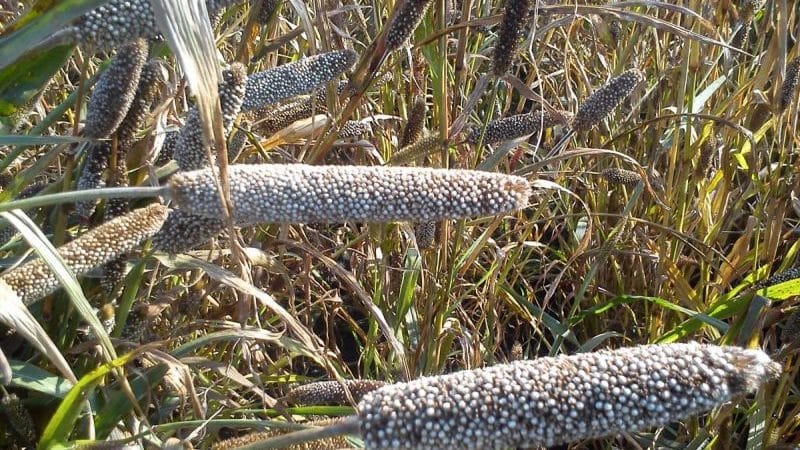
Description and characteristics of the plant Pennisetum gray
Pennisetum is a herbaceous cereal plant whose height reaches 4 m with proper care. Its roots can go 3.5 m into the ground, however, most of them are located at a depth of 10 cm.
Pearl millet leaves are dark green in color. The inflorescences are in the form of protruding dense panicles 20 cm long. Each branch on average consists of 9 spikelets with densely pubescent axes and fluffy short bristles. Flowering lasts from July to September.
The infructescence contains several thousand grains, reaching 5 mm in diameter. Their colors are different: white, yellow, red, black.
Reference. The grass can be propagated by seeds or cuttings. Seeds are sown in open ground in early May, for seedlings - in the second half of April.
Types and varieties
The most popular types of pearl millet include:
- Pennisetum foxtail. The plant successfully winters in central Russia. It is characterized by the formation of a wide bush with a height of 40 cm to 1 m. There are also low-growing varieties of this plant. The leaves of the crop are narrow, green, and turn yellow in autumn. Flowering period: August – September. Low-growing varieties bloom earlier - in July. The inflorescences look like fluffy panicles with a color ranging from light milky to brownish-red. Homeland - eastern regions of Asia, Australia.
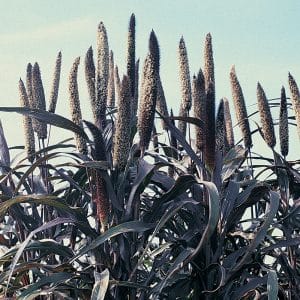
- Pennisetum orientalis. Perennial. In nature it grows on rocky soil of slopes, on tropical and subtropical screes of Asia and Africa. The height of the stem reaches from 15 to 80 cm. The panicles are dense and look like spikelets. The inflorescences reach from 4 to 15 cm in length and are pinkish-brown in color. Wintering is tolerated only in areas where there are no severe frosts.
- Pennisetum shaggy. It is a perennial plant native to East Africa. It grows naturally on screes and slopes in mountainous areas. It reaches a height of 30-60 cm, forming dense clumps. The panicles are spike-shaped from 3 to 10 cm in length, cylindrical in shape, golden in color. They bloom in August. Inflorescences appear in the second year after planting. Winters well in the southern regions.
- Pennisetum simplex. A more cold-resistant species. Homeland - China. It grows in mountainous areas, forming massive clumps up to 1.2 m high. The foliage is green or gray-green. Blooms in late June.Flowering lasts until September. The inflorescences first have a greenish tint, then become yellow-brown. The plant's rhizomes can choke out other plants.
- Pennisetum glaucous. The culture is valued for its unusual bronze color of its wide, about 3.5 cm, leaves. The height of the plant can reach 2 m. It is a food and fodder cereal. In Europe it is valued as a decorative crop. Grows quickly. Used as an annual plant in cold climates.
Popular varieties of Pennisetum glaucous:
- African Purple - the entire plant, including panicles, has a purple-bronze color;
- Jester is a late flowering variety, height up to 120 cm;
- Purple Baron - height up to 1 m, stems and inflorescences purple;
- Purple Majesty is a red-leaved variety, up to 1.5 m high, with purple straight inflorescences;
- Princess Jade - height 0.9-1.2 m, with bright green foliage and burgundy spikelets in inflorescences.
Economic importance and application
Pearl millet has composition rich in nutrients. This is a high-yielding crop, quite suitable for food. One multi-stemmed plant can contain up to 15 ears.
Pearl millet is used in the preparation of flatbreads, porridges, and beer-like drinks.
The stems and leaves of the plant are used as livestock feed. They make hay from them.
Reference. When dried, the stems of the pinnately bristlecone look beautiful in a vase.
Cirrus bristle is widely used in landscape design. Low decorative types of pennisetum are used for lining flower beds, fences and paths in personal plots.
Landscape designers plant crops in mixborders, decorate fences, retaining walls, and buildings with plants.Tall varieties have found use as hedges.
Reference. Perennial varieties in cold climates are best planted in containers. They tolerate harsh winters well in a cool room.
History of appearance
Cirrus bristles were cultivated in Africa 30 centuries ago. Over time, the plant spread throughout Asia, becoming well established in India and Burma, where it is still grown today in arid tropical conditions at altitudes from 800 to 1800 m above sea level.
Chemical composition, microelements, calorie content of pearl millet
Pennisetum grains have a high nutritional value and good shelf life. They contain: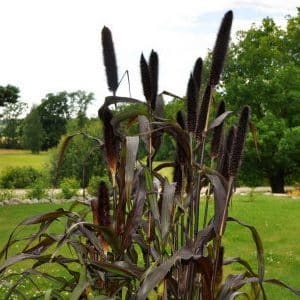
- carbohydrates – 56-76%;
- protein – 9-16%;
- fats – 4-6%;
- ash – 2-7%.
Millet contains a lot of useful substances:
- microelements - phosphorus, magnesium, zinc, copper, iodine;
- vitamins - pantothenic, folic, nicotinic acids.
Reference. African millet is the leader among cereals in terms of nicotinic acid content.
Calorie content per 100 g of product is 350 kcal.
Useful and healing properties of pearl millet
Due to its composition rich in vitamins and microelements, millet is considered a valuable food product with healing properties. Porridges made from it are a component of many therapeutic diets.
How it affects the body
Beneficial properties of pearl millet:
- removes toxins from the body due to the fiber contained in grains;
- has a diuretic effect, solves the problem of swelling;
- has a beneficial effect on the nervous system due to the high content of folic acid;
- improves the condition of the cardiovascular system due to its high potassium content.
Features of growing in open ground
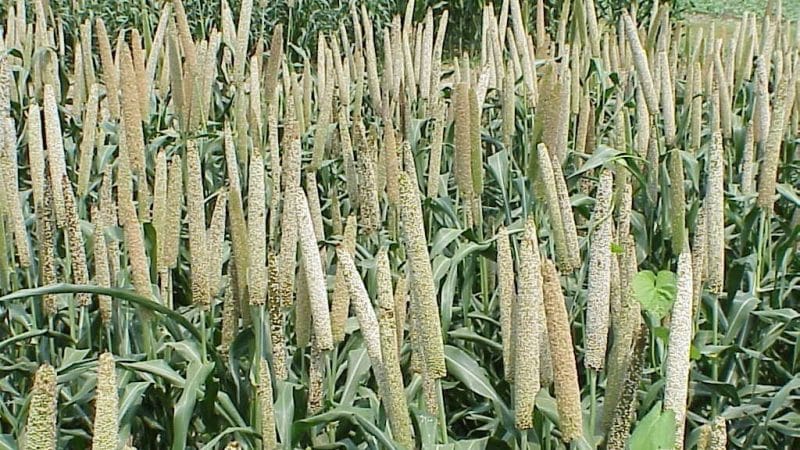
Growing pennisetum is possible from seeds or cuttings.The first method is suitable for annual plants, the second - for perennials.
Compliance with the rules of agricultural technology is the key to healthy plantings.
Annuals are sown in pots in the spring; in May they can be transferred to the flower garden. It is permissible to sow seeds in early May in open ground, covering the planting with film.
Choosing a landing site
Culture loves the sun. The planting area should be well lit and protected from drafts. Cirrus bristles take root well if planted in a row along a fence or building wall.
Important. Adult plants are not kept in a greenhouse.
Soil preparation
The culture grows well in fertile, moist soil with a pH of 5.5 to 7.0.
The area (usually a strip along the fence) is prepared for planting pearl millet in advance: it is cleared of weeds, dug up, and leveled. Loosen the soil shallowly, 10-15 cm.
Reference. It is recommended to apply fertilizers: phosphorus, potassium, nitrogen. Fertilizing with nitrogen will need to be repeated a month after sowing.
Seed preparation
Before planting, the seed cover is removed to stimulate germination. To increase resistance to frost, the seed material is sorted and moistened.
Planting scheme and technology
In summer cottages, millet is sown by hand. The grains are scattered evenly, 5-6 pieces per hole. The distance between the holes is at least 45 cm.
Industrial sowing is carried out using seeders with wide row spacing - about 100 cm.
Reference. In Africa and India, pennisetum is planted in the field as seedlings. It is grown for a month in a nursery. In open ground, several plants are planted in each hole.
Seedlings are planted when the seedlings reach a height of 15 cm after the threat of frost has passed.
Treatment against diseases and pests
Cereals are rarely affected by diseases and pests. The exception is rust, a fungal disease that affects cereal crops and garden trees. Among the main predisposing factors of the disease is increased soil moisture. The problem can be solved with the help of fungicides and replanting the plant in new soil.
Infestation by scale insects (small insects) is determined by the voids and red or yellow spots that appear on the stems. You will need to use a soap solution, fern tincture, Permethrin, Phosfamide.
Infestation by aphids often leads to the death of pennisetum. For prevention and treatment, summer residents practice using a soap solution or the drug “Intavir”.
Important. Excessive watering can cause stem rotting. If signs of waterlogging appear, stop watering the planting.
Features of care
Caring for pennisetum is simple and consists of:
- in loosening the soil - it will need to be done 2-3 times per season;
- manual weeding, especially at the initial stage of growth, so that weeds do not choke out the crop;
- hilling up tall crops;
- watering: during the dry season from July to August, at least 4 irrigations along the furrows will be required;
- applying fertilizers, mineral with nitrogen, potassium and phosphorus and organic such as manure.
Reference. For feeding you can use “Kristalon”, “Plantafol”, “Ammophos”.
Tips and tricks for growing and using pearl millet
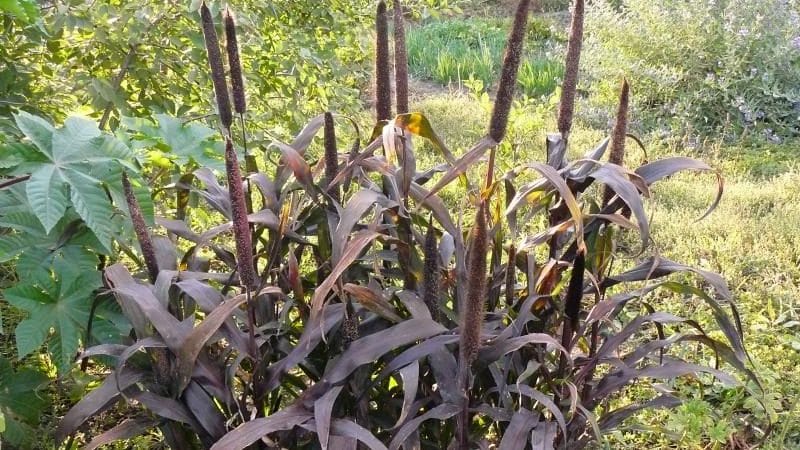
In order for pennisetum to grow well, avoid stagnation of water. Drainage is required at the site where pearl millet is planted in the ground.
The perennial frost-resistant crop is not pruned before winter. The above-ground part of the plant serves as a natural shelter for the roots.The root area will need to be covered with fallen leaves. In spring, the insulation is removed, and last year’s above-ground part of the bush is cut off.
Reference. Cirrus bristlecone beautifully frames ponds and fits perfectly into the design of flower beds. Its weeping leaves look very harmonious in combination with other plants. Pennisetum foxtail is perfect for decoration. It will become a large floral accent against the backdrop of massive stones. Designers recommend combining pearl millet in water compositions with marigold or cotula.
Conclusion
African millet - an ornamental plant popular among domestic gardeners, unpretentious in care and drought-resistant. It looks good both in solo form and as an element of a plant composition.